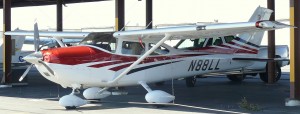A Cessna 172 on steroids? No not really. Something like that would have another name. Most in the aviation business know it as a Cessna 182 Skylane.
The two airplanes look very similar with tricycle landing gear, four seats, and a rakish tail. Once you start looking a little deeper, however, you start to notice the differences.
The first major difference you will notice right off the bat is the greater room in the cabin. Compared to the Cessna 172, the 182 is really spacious. You will notice the extra shoulder space and legroom immediately. Also the headroom because the cabin is taller.
Looking around the cockpit after settling into the pilot’s seat, you will probably notice the extra power control—the one for the propeller. The next thing you will probably take note of is the different sound of the engine. Once started, the engine sounds deeper, more powerful. Because it is.
A Lycoming IO-360 producing 180 hp powers the latest 172. The 182 on the other hand, has a 230 Continental O-470 converting fuel to noise to power the airplane through the air. The latest model 182s are being powered by the newer Lycoming engines also of 230 hp.
The airplane cruises nicely at an easy 135 knots. For this speed, you can count on fuel flow reaching 11 gallons per hour.
For takeoff, trim placement becomes more critical for the 182 than the 172. With the heavier nose, you need trim helping you rotate the plane off the deck. You could still do it by manually overriding the weight of the nose, but it is much easier and more professional if you have your trim set exactly right.
Climb is set at a typical power setting of 25 squared after the initial climb from the runway. Again, there is that meaty roar of the Continental as compared to the Lycoming that once leveled out in cruise flight, seems not to work as hard as the Lycoming for the airspeed.
The 172 has a maximum gross weight of 2400 pounds for the earlier models, 2550 for the latest. For the 182, the gross weight for the airplane starts at 2550 for the earliest models, and gradually increases to a maximum of 3100 pounds by 1980.
On landing, it again comes back to the use of trim. For a pilot to pull off a decent landing, trim technique is critical. On approach speed, the pilot must trim out the airplane so that it flies hands off at the appropriate on final approach. Once that is accomplished, the round out and flare is merely a matter of a slightly heftier pull than for the 172.
Like the 172, the 182 shares all those wonderful handling characteristics of most Cessnas. She flies easily, cruises well, is a stable instrument platform, and truly one of the best airplanes designed.
If you like the 172, you will really like the 182.
-30-
© 2011 J. Clark


Pingback: 100,000 Airplanes |